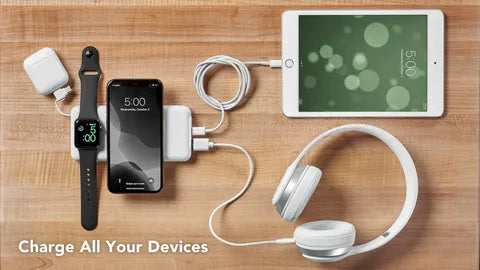USB cables are essential for charging our devices and transferring data, but they often wear out faster than we'd like. Whether it’s fraying at the ends, losing connection, or just not charging as efficiently, a broken cable can be frustrating. In this blog, we’ll share four simple tips to help you extend the lifespan of your USB cables—and introduce high-quality options from PowerBank.app that are built to last.
Why Do USB Cables Wear Out?
Before we dive into the tips, it’s important to understand why USB cables tend to break down over time. The most common reasons include:
- Frequent bending at the connector points.
- Pulling or yanking the cable out of devices.
- Excessive twisting or tangling during storage.
- Heat or environmental exposure that degrades the cable materials.
While no cable lasts forever, following a few best practices can significantly extend its life.
1. Avoid Bending the Cable at Sharp Angles
One of the most common reasons USB cables fail is because they are bent too sharply, especially near the connectors. This constant bending weakens the internal wires, causing them to break or fray.
What You Can Do:
- Use a cable organizer or cable clips to keep your cables straight and prevent them from getting bent at sharp angles.
- When connecting or disconnecting your devices, grip the connector, not the cable itself, to avoid unnecessary stress on the wire.
💡 Our Recommendation: The Juovi USB-C to Lightning Cable is designed with a reinforced connector that can withstand more than 10,000 bends, making it an excellent choice for durability.
2. Store Your Cables Properly
Improper storage is another major cause of cable damage. Many people simply toss their cables into a bag or drawer, where they get twisted, tangled, and damaged. Storing your cables neatly can help them last longer.
What You Can Do:
- Coil your cables loosely instead of tightly wrapping them around your hand or a device. Tight wrapping can cause internal damage.
- Use Velcro straps or cable ties to keep your cables organized and prevent tangling.
💡 Our Recommendation: The Juovi USB-C to USB-C Cable comes with a built-in cable tie, making it easy to store neatly without tangling or twisting. Its nylon-braided design also makes it more resistant to wear and tear.
3. Unplug Your Cables Gently
Yanking or pulling on your USB cable to unplug it from a device is a surefire way to damage it. Over time, this can loosen the connection between the cable and the connector, leading to poor charging or data transfer performance.
What You Can Do:
- Always unplug your cable by grabbing the connector, not the cable itself.
- Be mindful of how much force you use; USB connectors are designed to be inserted and removed easily without excessive pulling.
💡 Our Recommendation: The Juovi USB-C to Lightning Cable features reinforced connectors that are more resistant to wear from frequent plugging and unplugging, helping you avoid damage from everyday use.
4. Choose High-Quality, Durable Cables
Not all USB cables are created equal. Cheap, poorly made cables may save you a few dollars upfront, but they often wear out quickly and can even damage your devices. Investing in high-quality, durable cables can save you money and frustration in the long run.
What You Can Do:
- Look for cables with reinforced connectors and braided exteriors, which offer more durability than standard plastic cables.
- Choose cables that are certified for your devices. For example, if you’re using an Apple device, ensure the cable is MFi-certified (Made for iPhone/iPad).
💡 Our Recommendation: The Juovi USB-C to USB-C Cable and Juovi USB-C to Lightning Cable are both MFi-certified and built with premium materials like nylon braiding and reinforced connectors. These features ensure that the cables are not only durable but also safe for your devices.
Bonus Tip: Keep Your Cables Clean
Over time, dust, dirt, and debris can accumulate on your USB cables and connectors, leading to poor performance or even damage. Keeping your cables clean can help them last longer.
What You Can Do:
- Wipe down your cables with a soft, damp cloth to remove dirt and grime.
- Use a toothpick or compressed air to clean out the connectors, but be gentle to avoid damaging the pins.
Conclusion: Invest in Quality and Care
By following these simple tips—avoiding sharp bends, storing your cables properly, unplugging them gently, and investing in high-quality cables—you can significantly extend the lifespan of your USB cables. And when it’s time to upgrade, choosing durable, well-made cables like those from PowerBank.app will ensure that your investment pays off in the long run.
Ready to upgrade your cables? Check out our selection of durable, high-quality USB cables at PowerBank.app and keep your devices powered up without the hassle of constantly replacing worn-out cables.



